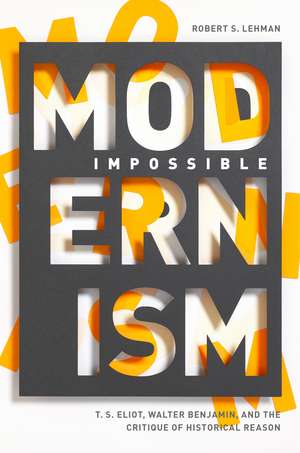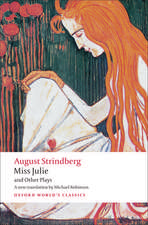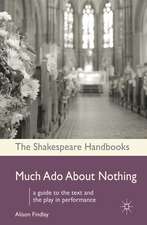Impossible Modernism: T. S. Eliot, Walter Benjamin, and the Critique of Historical Reason
Autor Robert Lehmanen Limba Engleză Hardback – 23 aug 2016
Preț: 482.06 lei
Nou
92.24€ • 96.57$ • 76.32£
Carte tipărită la comandă
Livrare economică 05-19 aprilie
Specificații
ISBN-10: 0804799040
Pagini: 272
Dimensiuni: 152 x 229 x 20 mm
Greutate: 0.5 kg
Editura: Stanford University Press
Colecția Stanford University Press
Recenzii
Notă biografică
Cuprins
The Introduction examines three moments that have proven foundational for the fraught relationship between poetry and history. The first occurs in the fourth century B. C. in Aristotle's Poetics, the earliest attempt to provide a systematic definition of the structure and effects of poetry and, consequently, the origin of all later crises of verse. The second appears in Marx's Eighteenth Brumaire, a text that offers a complicated poetic response to a moment of crisis in Marx's own historical method. The third appears in the early writings of Friedrich Nietzsche, where, against the onset of the nineteenth-century science of history, the demand to see history become poetry is made explicit. Focusing on these three moments, the Introduction establishes the intellectual-historical coordinates of the poetico-historical problem that T. S. Eliot and Walter Benjamin inherit.
The first chapter addresses T. S. Eliot's struggle with history as this struggle unfolds between 1910 and 1920, between the composition of "The Love Song of J. Alfred Prufrock" and the publication of "Gerontion." Challenging readings of Eliot's project as, from its inception, conciliatory¿the terminus of a certain narrative of literary modernism, the moment when modernism became reconciled to its institutional status¿this chapter reveals in Eliot's lyric practice an opposed tendency. During the 1910s, Eliot characterizes the poetic ordering of literary history not only as a synthesis of diverse works but also as a practice whose success depends on a series of divisions, divisions inscribed in the consciousness or the life of the "mature poet" and reduplicated in the poet's literary creations.
The second chapter treats the formal role played by satire in the drafts of The Waste Land, focusing in particular on T. S. Eliot's parody of Alexander Pope's Rape of the Lock in an early version of "The Fire Sermon." In Eliot's hands, satire becomes a means of responding to a specifically modernist crisis in aesthetic judgment: the seeming impossibility of distinguishing, after the collapse of traditional standards of beauty, popular charlatans from individuals of real talent. By placing The Waste Land under the sign of satire, Eliot attempts to distinguish his long poem from the wasteland of literary history that it recollects. The disappearance of satire from the final version of The Waste Land following the editorial suggestions of Pound, and Eliot's replacement of his earlier satirical method by the so-called "mythical method" reflect satire's failure to accomplish its task.
The third chapter focuses on T. S. Eliot's turn to the "mythical method" as a strategy of literary creation through division. Examining the delimitation in The Waste Land of the history of verse as it develops from Chaucer to Whitman, it shows that Eliot turns to myth not to forge connections with something temporally or spatially other but to cut his poem free from its literary-historical past. Within the realm of myth, broken off from the unending historical cycles that provide The Waste Land with its subject matter, Eliot attempts to place the poet's creative act. The results are volatile: history remains, in the poem, the space of production, however fallen its products, while myth stands apart from history as a space where nothing¿not history and certainly not literary history¿happens.
The book's fourth chapter reads Walter Benjamin's earliest programmatic writings in light of early-twentieth-century debates over the legacy of Kantianism. And it treats in particular Benjamin's attempt to replace Kant's transcendental philosophy¿Kant's ostensibly complete description of the conditions of human cognition¿with what Benjamin refers to as a "doctrine of orders," a system of interlinked but non-identical structures of knowledge derived from linguistics, theology, aesthetics and other domains. It finds Benjamin taking seriously Kant's claim that human experience is constitutively finite and expanding this notion of constitutive finitude to include the Kantian transcendental itself, leaving the latter open to transformation through its encounters with a material, historical outside. Although references to Kant are rare in Benjamin's later writings, a modified version of Kant's philosophy¿this is the claim of the chapter¿is the foundation for Benjamin's later critique of historicism.
Focusing on some of Walter Benjamin's scattered remarks on "anecdote" in The Arcades Project and ancillary works, this chapter asks how anecdote came to appear to Benjamin to provide a critical model of historical perception, critical in the sense that it eludes the failings of both the rationalist approach to the past (which Benjamin associates with Hegel) and the empiricist approach to the past (which Benjamin associates with Ranke). It argues, finally, that the critical, anecdotal model of historical perception is concretized in Benjamin's late "physiognomies," that is, in his examinations of the gambler, the flâneur, the melancholic and other modern historical types. These figures and their diverse forms of life provide historical time with the "standard" that Benjamin seeks.
This chapter concerns the role of allegory in Walter Benjamin's writings, and specifically on the challenge that allegory presents to time as the latter manifests itself by ordering human history. Benjamin develops his allegorical challenge to time in The Origin of German Tragic Drama, his studies of Baudelaire and, most profoundly, the ninth thesis "On the Concept of History." In the last of these texts, Benjamin's allegorical presentation of the "new angel" depicts a vision of history without time, a vision in which events occur absent any temporal continuity. In this impossible vision, the critical force of what Benjamin calls the "allegorical intention" emerges.
Impossible Modernism concludes with a short discussion of two figures: the flash of lightning that cuts across the desert scene in the last section of The Waste Land and the "storm of progress" that blows through the ninth thesis "On the Concept of History." These images, it is maintained, in their attempt to present together tradition, on the one hand, and event, on the other, bring to the fore modernism's paradoxical historical imagination, and the relevance of this imagination to our contemporary aesthetic and political concerns.















